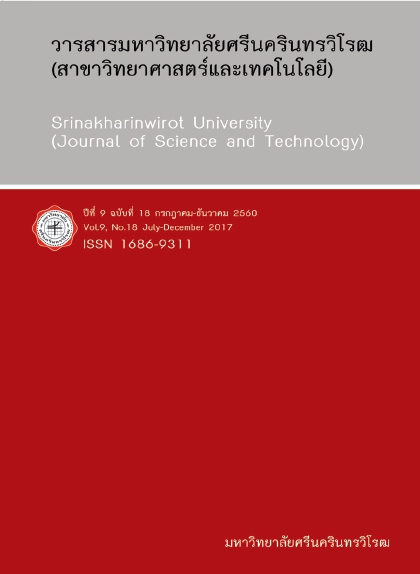ทอรีนและฮีสตามีนในตัวอย่างปลาทะเล และปลาน้ำจืด (TAURINE AND HISTAMINE IN SEAFISH AND FRESHWATER FISH SAMPLES)
Keywords:
Siamese Elite, King Taksin the GreatAbstract
The aim of this research was to simultaneous analysis taurine and histamine content in fish samples as seafish and freshwater fish of Thailand by high-performance liquid chromatography and derivatied with o-phthalaldehyde (OPA). The optimization of HPLC conditions for quantitative analysis of taurine and histamine were obtained. The optimum conditions for mobile phase system were 0.02 M phosphate buffer pH 4.8 : acetonitrile as 65:35, controlled flow rate at 0.8 mL/min and detected by fluorescence detector with fluorescence excitation and emission peaks at 333 and 451 nm, respectively. This condition could separated taurine and histamine within 10 mins, retention time of taurine and histamine were 5.415 and 8.483 mins, respectively. Validation method of the analysis was also studied and the calibration curve showed a linearity range of 0.0005 - 10 and 0.03 - 10 mg/L for taurine and histamine, respectively, with the correlation coefficients (R2) of taurine and histamine as 0.9975 and 0.9980 respectively. The limits of detection (LOD) and limits of quantitation (LOQ) of taurine and histamine presented as 0.0001 mg/L and 0.0005 mg/L for taurine and 0.01 mg/L and 0.03 mg/L for histamine. The method was showed an effective separation of both taurine and histamine and applied to quantity of taurine and histamine in fish samples. Taurine in Thai fishes samples were found in the range of 490.81±1.7 - 1721.92±1.9 mg/kg. Histamine in Thai fishes were found in the range of 6.78±0.2 - 19.07±1.4 mg/kg. The effects of processing on fish samples such as boiling, steaming and frying were studied and the results revealed that taurine and histamine content depend on processing method.
Downloads
References
samples. Journal of Chromatography B. 781: 251-267.
[2] ประสงค์ เทียนบุญ. (2547). ทอรีน. วารสารโภชนะบำบัด. 15(1): 23-32.
[3] Valeria, F.; & Claudia, L. (1998). Histamine and histidine determination in tuna fish samples using
high-performance liquid chromatography Derivatization with o-phthalaldehyde and fluorescence
detection or UV detection of ‘‘free’’ species. Journal of Chromatography A. 809: 241–245.
[4] ยุพิน สังวรินทะ; และคณะ. (2537). เภสัชวิทยา. กรุงเทพฯ: ภาควิชาเภสัชวิทยา คณะวิทยาศาสตร์
มหาวิทยาลัยมหิดล.
[5] จิรวัฒน์ ยงสวัสดิกุล; และคณะ. (2546). ปัจจัยที่มีผลต่อปริมาณฮีสตามีนในกระบวนการผลิตน้ำปลา.
ใน เอกสารรายงานการวิจัย. มหาวิทยาลัยเทคโนโลยีสุรนารี.
[6] Food and Drug Administration, USA. (1995). Decomposition and histamine-raw frozen tuna and
mahi–mahi; canned tuna; and related species; availability of revised compliance policy guide.
Federal Registration. 60: 39754–39756.
[7] Pappa-Louisi, A.; Sotiropoulos, S.; & Balkat zopoulou, P. (2008). Mobile phase pH, column
temperature, and eluent flow rate effects on separation and fluorescence electrochemical detection
of OPA derivatives of amino acids in reversed-phase liquid chromatography. Journal of Liquid
Chromatography & Related Technologies. 31: 1434-1447.
[8] Silva, C.C.G.; Da Ponte, D.J.B.; & Enes Dapkevicius, M.L.N. (1998). Storage temperature effect on
histamine formation in big eye tuna and skipjack. Journal of Food Science. 63: 644-647.
[9] World Health Organization & Food and Agriculture Organization of the United Nations. (2012).
Joint FAO/WHO expert meeting on the public health risks of histamine and other biogenic amines
from fish and fishery products: meeting report. Rome Italy: FAO headquarters.
Downloads
Published
How to Cite
Issue
Section
License
Srinakharinwirot University Journal of Sciences and Technology is licensed Under a Creative Commons Attribution-NonCommercial-NoDerivs 4.0 International (CC-BY-NC-ND 4.0) License, Unless Otherwise Stated. Please Read Journal Policies Page for More Information on Open Access, Copyright and Permissions.



